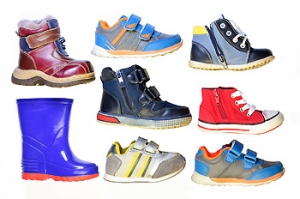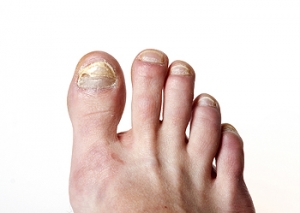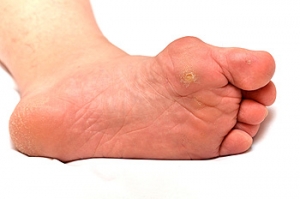Connect With Us
Featured Articles
Super User
Morton's Neuroma
Morton's Neuroma, also called Intermetatarsal Neuroma or Plantar Neuroma, is a condition that affects the nerves of the feet, usually the area between the third and fourth toe. Neuroma refers to a benign growth that can occur in different parts of the body. Morton's Neuroma strictly affects the feet. This condition causes the tissue around the nerves that lead to the toes becoming thick, causing pain in the ball of the foot.
This condition can be caused by injury, pressure or irritation. Normally no lump will be felt, but instead burning pain in the ball of the foot will be experienced. Numbness and tingling may also occur. With the onset of this condition, a person may feel pain when tight or narrow shoes are worn. As the condition worsens, the pain may persist for days, or even weeks.
Persistent foot pain should always be a concern. The foot should be examined by a podiatrist if pain persists longer than a few days with no relief from changing shoes. The earlier the foot is examined and treated, the less chance there will be for surgical treatment.
There are some factors that can play a role in the development of Morton's Neuroma. These include wearing ill-fitting shoes that cause pressure to the toes, such as high heels. Also, high impact exercise may contribute to the cause of this condition. Morton’s Neuroma may also develop if the foot sustains an injury. Another cause includes walking abnormally due to bunions or flat feet. This causes excessive pressure and irritates the tissue. At times, people are affected for no determinable reason.
Podiatrists can alleviate the effects of this condition using a treatment plan to help decrease the pain and heal the foot tissue. Depending upon the severity of the Morton's Neuroma, the treatment plan can vary. For cases that are mild to moderate, treatments may include applying padding to the arch to relieve pressure from the nerve and reduce compression while walking. Ice packs can also help reduce swelling. The podiatrist may also create a custom orthotic device to support the foot and reduce compression and pressure on the affected nerve. The doctor will probably advise against partaking in activities that cause constant pressure on the affected area. They may provide wider shoes to ease the pressure from the toes. If these treatments do not relieve the symptoms of this condition, the doctor may use injection therapy.
Surgical treatment may be recommended by the podiatrist if all other treatments fail to provide relief. Normally, the podiatric surgeon will decide on either a surgical procedure that involves removal of the affected nerve or will choose surgery to release the nerve. After examination, the surgeon will decide on the best approach to treat the problem.
Recovery varies according to the type of surgical procedure. The patient will also be instructed on the best shoe wear to prevent the return of this condition, along with changes to workout routines, if this was a cause. Preventative measures are important in ensuring the condition does not return.
What Causes Cuboid Syndrome?
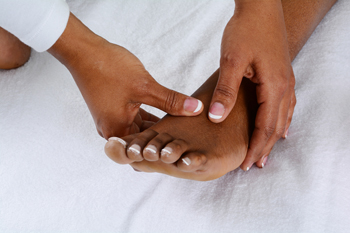 The cuboid bone is located in the mid portion of the foot. There are several bones that surround it, and may often become noticed after an injury has occurred. If an ankle sprain happens, the cuboid bone may become displaced, and may often be gently manipulated back into place. There are several symptoms that may be associated with this uncomfortable condition, including a feeling of weakness in the ankle and foot, significant swelling, and the area may be tender when touched. Research has shown that common causes for this type of ailment to occur is typically an injury to the foot or trauma the foot endures. People who are actively involved in sports may be prone to develop cuboid syndrome, and this may be a result of excessive running or jumping. It’s suggested to speak with a podiatrist if you feel you have developed this condition so proper treatment techniques and advice can begin, which may include wearing insoles that support the arch.
The cuboid bone is located in the mid portion of the foot. There are several bones that surround it, and may often become noticed after an injury has occurred. If an ankle sprain happens, the cuboid bone may become displaced, and may often be gently manipulated back into place. There are several symptoms that may be associated with this uncomfortable condition, including a feeling of weakness in the ankle and foot, significant swelling, and the area may be tender when touched. Research has shown that common causes for this type of ailment to occur is typically an injury to the foot or trauma the foot endures. People who are actively involved in sports may be prone to develop cuboid syndrome, and this may be a result of excessive running or jumping. It’s suggested to speak with a podiatrist if you feel you have developed this condition so proper treatment techniques and advice can begin, which may include wearing insoles that support the arch.
Cuboid syndrome, also known as cuboid subluxation, occurs when the joints and ligaments near the cuboid bone in the foot become torn. If you have cuboid syndrome, consult with Dr. Thong V. Truong from California. Our doctor will assess your condition and provide you with quality foot and ankle treatment.
Cuboid syndrome is a common cause of lateral foot pain, which is pain on the outside of the foot. The condition may happen suddenly due to an ankle sprain, or it may develop slowly overtime from repetitive tension through the bone and surrounding structures.
Causes
The most common causes of cuboid syndrome include:
- Injury – The most common cause of this ailment is an ankle sprain.
- Repetitive Strain – Tension placed through the peroneus longus muscle from repetitive activities such as jumping and running may cause excessive traction on the bone causing it to sublux.
- Altered Foot Biomechanics – Most people suffering from cuboid subluxation have flat feet.
Symptoms
A common symptom of cuboid syndrome is pain along the outside of the foot which can be felt in the ankle and toes. This pain may create walking difficulties and may cause those with the condition to walk with a limp.
Diagnosis
Diagnosis of cuboid syndrome is often difficult, and it is often misdiagnosed. X-rays, MRIs and CT scans often fail to properly show the cuboid subluxation. Although there isn’t a specific test used to diagnose cuboid syndrome, your podiatrist will usually check if pain is felt while pressing firmly on the cuboid bone of your foot.
Treatment
Just as the range of causes varies widely, so do treatments. Some more common treatments are ice therapy, rest, exercise, taping, and orthotics.
If you have any questions, please feel free to contact our office located in Chico, CA . We offer the newest diagnostic and treatment technologies for all your foot care needs.
Cuboid Syndrome
Cuboid syndrome mostly affects athletes, although it can affect non-athletes too. It is also known as cuboid subluxation or cuboid fault syndrome. This condition occurs when joints and ligaments near the cuboid bone of the foot are damaged, or when the cuboid bone itself is dislodged from its natural position. It is usually marked by pain on the outer side of the foot, which may be persistent or may come and go. Cuboid syndrome can be difficult to diagnose unless it becomes severe and more noticeable. Your doctor will likely ask questions about when the pain began and how long it has been present, and will put pressure on the cuboid bone to determine if that area is the origin of the pain.
Causes of Cuboid Syndrome
- Any repetitive stresses placed on the foot due to athletic activities are a common cause of cuboid syndrome.
- Although it develops over time, it is possible that this syndrome can occur all of sudden due to a single event or injury.
- Over-pronation can exacerbate the condition if not corrected.
Disagreements Amongst Podiatrists Regarding Cuboid Syndrome
- Some refer to it as the dislocation of the calcaneal-cuboid joint only.
- Other podiatrists see it as an injury of the ligaments located nearby, which also involves the cuboid bone.
It is very important that when you experience any kind of pain on the side of your foot, you should seek medical care right away. If a subluxed cuboid is caught early, your feet may respond well to the treatment, and you can get back into sports or other activities again as soon as the pain subsides.
How To Teach Your Child About Proper Foot Care
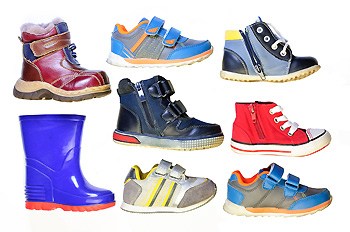 Research has shown the importance of teaching children at a young age how to perform proper foot care. This process may begin with educating the child about their feet. For example, feet are comprised of 26 bones, and the strongest two are the heel bone and the talus bone. These bones carry the majority of the body’s weight as daily activities are pursued. Additionally, proper foot hygiene is important to learn and practice daily, and this may prevent certain uncomfortable foot conditions from developing. This may be accomplished by washing and drying the feet thoroughly every day, walking barefoot in the house, which may aid in helping to spread the toes out, and learning how to trim the toenails properly. Additionally, it’s important for the child to notice any pain or discomfort in their feet, which may be a result of improperly fitting shoes or socks. If this should occur, it’s suggested to visit a podiatrist who can help guide the parents in learning about proper foot care for their child.
Research has shown the importance of teaching children at a young age how to perform proper foot care. This process may begin with educating the child about their feet. For example, feet are comprised of 26 bones, and the strongest two are the heel bone and the talus bone. These bones carry the majority of the body’s weight as daily activities are pursued. Additionally, proper foot hygiene is important to learn and practice daily, and this may prevent certain uncomfortable foot conditions from developing. This may be accomplished by washing and drying the feet thoroughly every day, walking barefoot in the house, which may aid in helping to spread the toes out, and learning how to trim the toenails properly. Additionally, it’s important for the child to notice any pain or discomfort in their feet, which may be a result of improperly fitting shoes or socks. If this should occur, it’s suggested to visit a podiatrist who can help guide the parents in learning about proper foot care for their child.
The health of a child’s feet is vital to their overall well-being. If you have any questions regarding foot health, contact Dr. Thong V. Truong of California. Our doctor can provide the care you need to keep you pain-free and on your feet.
Tips for Keeping Children's Feet Healthy
- Make sure their shoes fit properly
- Look for any signs of in-toeing or out-toeing
- Check to see if they have Clubfoot (condition that affects your child’s foot and ankle, twisting the heel and toes inward) which is one of the most common nonmajor birth defects.
- Lightly cover your baby’s feet (Tight covers may keep your baby from moving their feet freely, and could prevent normal development)
- Allow your toddler to go shoeless (Shoes can be restricting for a young child’s foot)
- Cut toenails straight across to avoid ingrown toenails
- Keep your child’s foot clean and dry
- Cover cuts and scrapes. Wash any scratches with soap and water and cover them with a bandage until they’ve healed.
If you have any questions, please feel free to contact our office located in Chico, CA . We offer the newest diagnostic and treatment technologies for all your foot care needs.
Causes and Symptoms of Hammertoes
 A permanently bent toe typically signifies a condition known as hammertoe. Severe pain may accompany this condition and may result in other foot ailments. The most common reason behind hammertoe development is poorly fitting shoes that squeeze the toe into a smaller than adequate area. It's suggested to keep the toes as flat as possible to avoid corns and blisters from developing. Additional causes may include having a predisposed inherited gene, diabetes, and arthritis. Severe injuries, such as stubbing your toe, may change the structure of the toe and may possibly cause this condition. In addition to noticing the bent toe, there are other symptoms that are indicative of hammertoes. These include the toe becoming red and swollen and limited movement caused by intense pain. Please schedule a consultation with a podiatrist for more information and treatment options, which may include surgery.
A permanently bent toe typically signifies a condition known as hammertoe. Severe pain may accompany this condition and may result in other foot ailments. The most common reason behind hammertoe development is poorly fitting shoes that squeeze the toe into a smaller than adequate area. It's suggested to keep the toes as flat as possible to avoid corns and blisters from developing. Additional causes may include having a predisposed inherited gene, diabetes, and arthritis. Severe injuries, such as stubbing your toe, may change the structure of the toe and may possibly cause this condition. In addition to noticing the bent toe, there are other symptoms that are indicative of hammertoes. These include the toe becoming red and swollen and limited movement caused by intense pain. Please schedule a consultation with a podiatrist for more information and treatment options, which may include surgery.
Hammertoe
Hammertoes can be a painful condition to live with. For more information, contact Dr. Thong V. Truong from California. Our doctor will answer any of your foot- and ankle-related questions.
Hammertoe is a foot deformity that affects the joints of the second, third, fourth, or fifth toes of your feet. It is a painful foot condition in which these toes curl and arch up, which can often lead to pain when wearing footwear.
Symptoms
- Pain in the affected toes
- Development of corns or calluses due to friction
- Inflammation
- Redness
- Contracture of the toes
Causes
Genetics – People who are genetically predisposed to hammertoe are often more susceptible
Arthritis – Because arthritis affects the joints in your toes, further deformities stemming from arthritis can occur
Trauma – Direct trauma to the toes could potentially lead to hammertoe
Ill-fitting shoes – Undue pressure on the front of the toes from ill-fitting shoes can potentially lead to the development of hammertoe
Treatment
Orthotics – Custom made inserts can be used to help relieve pressure placed on the toes and therefore relieve some of the pain associated with it
Medications – Oral medications such as anti-inflammatories or NSAIDs could be used to treat the pain and inflammation hammertoes causes. Injections of corticosteroids are also sometimes used
Surgery – In more severe cases where the hammertoes have become more rigid, foot surgery is a potential option
If you have any questions please contact our office located in Chico, CA . We offer the newest diagnostic and treatment technologies for all your foot and ankle needs.
How To Prevent Toenail Fungus
 If your toenails have turned yellow and are brittle and cracking, you may have what is referred to as toenail fungus. It is caused by a fungus that can get into the toenail through small cracks that are in the skin around the nails, and in more severe cases, extreme discomfort may be experienced. The surrounding skin may be susceptible to this fungus due to several reasons. These may include having a compromised immune system, an injury that has happened to the nail, or having athlete’s foot. Treatment options may include using an antifungal cream. In more severe cases, an oral medication is administered. Fungal infections are known to be stubborn. Several prevention techniques exist, including keeping the feet clean and dry, especially in between the toes, making sure your toenail clippers are not shared with anyone else, and wearing appropriate shoes in public showers. Please consider scheduling a consultation with a podiatrist for additional information about toenail fungus.
If your toenails have turned yellow and are brittle and cracking, you may have what is referred to as toenail fungus. It is caused by a fungus that can get into the toenail through small cracks that are in the skin around the nails, and in more severe cases, extreme discomfort may be experienced. The surrounding skin may be susceptible to this fungus due to several reasons. These may include having a compromised immune system, an injury that has happened to the nail, or having athlete’s foot. Treatment options may include using an antifungal cream. In more severe cases, an oral medication is administered. Fungal infections are known to be stubborn. Several prevention techniques exist, including keeping the feet clean and dry, especially in between the toes, making sure your toenail clippers are not shared with anyone else, and wearing appropriate shoes in public showers. Please consider scheduling a consultation with a podiatrist for additional information about toenail fungus.
For more information about treatment, contact Dr. Thong V. Truong of California. Our doctor can provide the care you need to keep you pain-free and on your feet.
Toenail Fungus Treatment
Toenail fungus is a condition that affects many people and can be especially hard to get rid of. Fortunately, there are several methods to go about treating and avoiding it.
Antifungals & Deterrence
Oral antifungal medicine has been shown to be effective in many cases. It is important to consult with a podiatrist to determine the proper regiment for you, or potentially explore other options.
Applying foot powder on the feet and shoes helps keep the feet free of moisture and sweat.
Sandals or open toed shoes – Wearing these will allow air movement and help keep feet dry. They also expose your feet to light, which fungus cannot tolerate. Socks with moisture wicking material also help as well.
If you have any questions please feel free to contact our office located in Chico, CA . We offer the newest diagnostic tools and technology to treat your foot and ankle needs.
Causes and Treatment Options for Bunions
 If you have a growth on the bottom of the big toe that appears to be of a bony consistency, you may have what is referred to as a bunion. Symptoms of this condition may consist of pain and swelling around the big toe, in addition to the area feeling sore, and appearing red. They are often caused by a predisposed inherited gene. Additionally, choosing to wear shoes that fit poorly may be another possible cause of bunions. This condition may be more prevalent in women than men because of the type of shoes that are worn. This may occur if high heels are worn frequently, causing the toes to be cramped into a small area, which eventually may change the structure of the foot. Treatment options may include using bunion pads which will cushion the affected area, and may possibly eliminate any discomfort. A consultation with a podiatrist may be considered to discuss proper treatment techniques which may include surgery.
If you have a growth on the bottom of the big toe that appears to be of a bony consistency, you may have what is referred to as a bunion. Symptoms of this condition may consist of pain and swelling around the big toe, in addition to the area feeling sore, and appearing red. They are often caused by a predisposed inherited gene. Additionally, choosing to wear shoes that fit poorly may be another possible cause of bunions. This condition may be more prevalent in women than men because of the type of shoes that are worn. This may occur if high heels are worn frequently, causing the toes to be cramped into a small area, which eventually may change the structure of the foot. Treatment options may include using bunion pads which will cushion the affected area, and may possibly eliminate any discomfort. A consultation with a podiatrist may be considered to discuss proper treatment techniques which may include surgery.
If you are suffering from bunions, contact Dr. Thong V. Truong of California. Our doctor can provide the care you need to keep you pain-free and on your feet.
What Is a Bunion?
A bunion is formed of swollen tissue or an enlargement of boney growth, usually located at the base joint of the toe that connects to the foot. The swelling occurs due to the bones in the big toe shifting inward, which impacts the other toes of the foot. This causes the area around the base of the big toe to become inflamed and painful.
Why Do Bunions Form?
Genetics – Susceptibility to bunions are often hereditary
Stress on the feet – Poorly fitted and uncomfortable footwear that places stress on feet, such as heels, can worsen existing bunions
How Are Bunions Diagnosed?
Doctors often perform two tests – blood tests and x-rays – when trying to diagnose bunions, especially in the early stages of development. Blood tests help determine if the foot pain is being caused by something else, such as arthritis, while x-rays provide a clear picture of your bone structure to your doctor.
How Are Bunions Treated?
- Refrain from wearing heels or similar shoes that cause discomfort
- Select wider shoes that can provide more comfort and reduce pain
- Anti-inflammatory and pain management drugs
- Orthotics or foot inserts
- Surgery
If you have any questions, please feel free to contact our office located in Chico, CA . We offer the newest diagnostic and treatment technologies for all your foot care needs.
How Do I Know If My Child’s Foot is Broken?
 A broken foot typically occurs from a fall or repeated activities that put stress on the foot. If your child complains of pain, swelling, and bruising, the chances are high that the foot is broken. To properly diagnose this condition, an x-ray, CAT scan, or MRI is typically taken, depending on the severity of the break. Once the broken foot is confirmed, treatment may consist of wearing a cast, which restricts movement in the leg and therefore allows healing to occur. Additional treatment suggestions include resting and elevating the foot by utilizing pillows. This may be beneficial in reducing any swelling that’s present. Obtaining a tetanus shot may be considered if the skin on the foot has cuts from the injury. A podiatrist is trained to handle a broken foot and should be contacted immediately if you suspect your child has suffered one.
A broken foot typically occurs from a fall or repeated activities that put stress on the foot. If your child complains of pain, swelling, and bruising, the chances are high that the foot is broken. To properly diagnose this condition, an x-ray, CAT scan, or MRI is typically taken, depending on the severity of the break. Once the broken foot is confirmed, treatment may consist of wearing a cast, which restricts movement in the leg and therefore allows healing to occur. Additional treatment suggestions include resting and elevating the foot by utilizing pillows. This may be beneficial in reducing any swelling that’s present. Obtaining a tetanus shot may be considered if the skin on the foot has cuts from the injury. A podiatrist is trained to handle a broken foot and should be contacted immediately if you suspect your child has suffered one.
A broken foot requires immediate medical attention and treatment. If you need your feet checked, contact Dr. Thong V. Truong from California. Our doctor can provide the care you need to keep you pain-free and on your feet.
Broken Foot Causes, Symptoms, and Treatment
A broken foot is caused by one of the bones in the foot typically breaking when bended, crushed, or stretched beyond its natural capabilities. Usually the location of the fracture indicates how the break occurred, whether it was through an object, fall, or any other type of injury.
Common Symptoms of Broken Feet:
- Bruising
- Pain
- Redness
- Swelling
- Blue in color
- Numbness
- Cold
- Misshapen
- Cuts
- Deformities
Those that suspect they have a broken foot shoot seek urgent medical attention where a medical professional could diagnose the severity.
Treatment for broken bones varies depending on the cause, severity and location. Some will require the use of splints, casts or crutches while others could even involve surgery to repair the broken bones. Personal care includes the use of ice and keeping the foot stabilized and elevated.
If you have any questions please feel free to contact our office located in Chico, CA . We offer the newest diagnostic and treatment technologies for all your foot and ankle needs.
Causes, Symptoms, and Treatment for a Broken Foot
One out of ten broken bones is reported to be in the feet. When an object crushes, bends, or stretches the bone beyond acceptable ranges, bones break. A break in the foot is either a fracture or a straight break.
The location of any break can tell you how the break happened. Toes, for instance, break typically as a result of something being kicked hard and with great force. Heel breaks almost always are a result of an improper landing from a tall height. Twists or sprains are the other two frequent occurrences. As with all usual breaks, they result from unexpected accident or sudden injury. As with stress fractures, breaks form as a process over time from repeated stress on already present cracks. Runners, dancers, and gymnasts are the usual athletes who receive this type of break. Stress fractures result from incredible pressure on the feet. It is no surprise these athletes bear the majority of reported fractures.
Pain, swelling, bruising, and redness are all indicative of the typical symptoms from a broken foot. Severe pain—to the point of not being able to walk—usually depends on the location of the break in the foot. Toes are on the lower scale of pain threshold, but heels are high, as are a few other particular bones. As the severity of the broken foot increases, symptoms like blueness, numbness, misshaping of the foot, cuts, or deformities will become apparent. These symptoms indicate the need to see a medical professional with access to an x-ray facility.
Prior to seeing a specialist, precautions should be taken to reduce pain and swelling. Elevate and stabilize the foot, and refrain from moving it. Immobilization of the foot is the next priority, so creating a homemade splint is acceptable. Keep in mind that while creating a splint, any increase of pain or cutting off blood circulation means that the splint should be removed immediately. Use ice to decrease swelling and relieve pain symptoms.
When dealing with a medical center, the patient should note that the treatment can vary. The treatment will depend on the severity of the fracture and the cause of the break. Crutches, splits, or casts are common treatments while surgery has been known to be used in more severe cases in order to repair the break in the bones.
Does My Baby Have an Ingrown Toenail?
When a toe is affected by the nail pressing into the skin, this condition is referred to as an ingrown toenail. This condition affects not only grown adults, but children and babies as well. Your baby may cry when the big toe rubs against a shoe or sock, and the tender skin will often be painful. A blister may emerge, and if an infection occurs, the discharge will be yellowish in color if it breaks. To prevent this condition, it’s recommended to use a nail clipper instead of scissors, which allows the nail to be cut straight across. Babies' feet typically grow fast, so it’s crucial to check the fit of the shoes and socks often. A consultation with a podiatrist may be advised for treatment options, which may include administering an antibiotic and possibly trimming the nail away from the skin.
Ingrown toenails can become painful if they are not treated properly. For more information about ingrown toenails, contact Dr. Thong V. Truong of California. Our doctor can provide the care you need to keep you pain-free and on your feet.
Ingrown Toenails
Ingrown toenails occur when a toenail grows sideways into the bed of the nail, causing pain, swelling, and possibly infection.
Causes
- Bacterial infections
- Improper nail cutting such as cutting it too short or not straight across
- Trauma to the toe, such as stubbing, which causes the nail to grow back irregularly
- Ill-fitting shoes that bunch the toes too close together
- Genetic predisposition
Prevention
Because ingrown toenails are not something found outside of shoe-wearing cultures, going barefoot as often as possible will decrease the likeliness of developing ingrown toenails. Wearing proper fitting shoes and using proper cutting techniques will also help decrease your risk of developing ingrown toenails.
Treatment
Ingrown toenails are a very treatable foot condition. In minor cases, soaking the affected area in salt or antibacterial soaps will not only help with the ingrown nail itself, but also help prevent any infections from occurring. In more severe cases, surgery is an option. In either case, speaking to your podiatrist about this condition will help you get a better understanding of specific treatment options that are right for you.
If you have any questions please feel free to contact our office located in Chico, CA . We offer the newest diagnostic and treatment technologies for all your foot and ankle needs.

